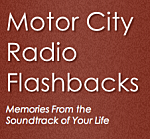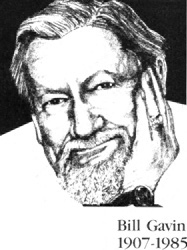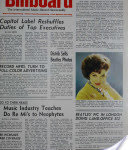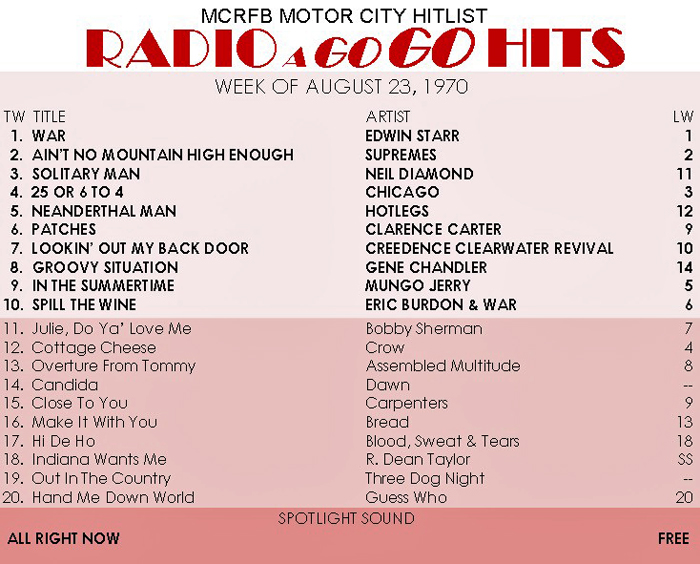 From the MCRFB NEWS archive: 1964
From the MCRFB NEWS archive: 1964
The Bill Gavin Newsletter July 25, 1964
From the Desk of Bill Gavin Billboard Contributing Editor
A S T A T I O N M A N A G E R recently said I don’t go along with this modern radio. My station programs for adults. “Let the formula stations entertain the kids.” I did my best to explain that “modern” radio means a lot more than that, but it didn’t do much good.
I asked another radio man what he thought about modern radio. “I’m all for it,” he said. “Our station is really modern, Top 40 survey, jingle package, time and temperature, news highlights every half hour, contests and prizes, keep the deejays from yakking — we’ve got all the modern gimmicks.”
 Interesting to note, neither of these gentlemen was speaking for a winning station. Manager No. I claimed that the audience measurement services were phony because he knew “lots of people” who listened to his station. Manager No. 2 is perpetually optimistic that the next rating will move him up out of the No. 4 spot to which his station currently clings.
Interesting to note, neither of these gentlemen was speaking for a winning station. Manager No. I claimed that the audience measurement services were phony because he knew “lots of people” who listened to his station. Manager No. 2 is perpetually optimistic that the next rating will move him up out of the No. 4 spot to which his station currently clings.
M O D E R N R A D I O is not teenage programming. Modern radio is not gimmicks, copied from some successful operation. There are so many different opinions about, and explanations of, modern radio that I offer the comments that follow with some difference, realizing that others may have a different and possibly a better description.
Modern radio starts with people. It grows out of a genuine respect for people’s interests, problems, tastes and feelings. Modern radio programming aims first at understanding what people want to hear, and then at giving them that plus something more. A continuing contact with living trends in all the many things it has to offer forms the basis of modern radio. Its program rule is objectivity. This is why sterile imitations of formulas and gimmicks show themselves so often to be vulnerable to aggressive competition. Modern radio, is briefly, audience centered.
Modern radio needs and uses a high degree of technical skill. The average listener seldom notices the expert efficiency with which records and tape cartridges are cued and started. Actually, if the technique is apparent to the listener, something is wrong with it. Skill and planning provide the continuous flow of sound and the feeling of movement that are characteristic of today’s most successful radio.
T O B E P R O F I T A B L E , radio must operate economically. In contrast to present day radio, the standards of the old network days seem incredibly wasteful, with their writers, producers and sound effects men, with announcers killing time while they waited to give the station call letters in between the network programs. The margin of profit is much smaller today, and the average effort required from each employee is proportionately greater.
Modern radio is more than entertainment. It is also companionship. It is a friendly voice in a hospital room, in a car, or in a lonely farm house. To be a companion, radio stations have emerged from the electronic anonymity of relay transmitters of entertainment, and have assumed personality and character of their own. Radio, like a good friend, is dependably there and dependably the same.
Pleasing an audience does not consist entirely of providing what people want. Very often, people don’t know what they like in the way of entertainment until they’ve tried it. Pleasing the audience consists largely in planning something that the audience will like. Surprise, novelty and variety are all part of modern radio. It takes creative imagination. often the combined work of many dedicated people, to keep radio continually alive and interesting. Some people call it showmanship.
Modern radio is the disk jockey. He is the voice of the station. He does much more than play records and talk about them. He may he casual or rapid fire; he may be witty or sincere; whatever he is, he is the key to a station’s acceptance
by the public.
M O D E R N R A D I O is a living part of its community. Whether it’s the support of the symphony or of a children’s hospital or of a high school record hop, radio is doing something with and about the community where it lives. The old promotion idea was, “Listen to us.” Today, radio listens to people. More and more stations are inviting listeners to phone, and the phone calls are being broadcast. Modern radio is successful in this joint participation project only as it demonstrates concern and awareness of its listeners as co-partners in the same community of interests.

News has always been an integral part of radio. Even television’s tremendous immediacy in the coverage of such major events as political conventions and the World Series has not reduced the listener appeal of radio’s consistently broader scale reporting.
The early 1950’s saw the beginning of the trend away from four to five quarter hour newscasts per day to the present prevailing practice of shorter summaries every hour or half hour. The news director in today’s radio is also a public relations director, guiding his station’s participation in community affairs.
Above all, modern radio is music. Practically all conceivable musical tastes can find satisfaction on radio’s AM and FM dials. The music comes, of course, from records. Without the rich variety of music made available by the record business, modern radio as we know it could not survive. A station’s selection of recorded music for airplay largely determines the type and size of its audience. Whether in the field of country music, blues, jazz, rock, pop or concert. Modern radio accepts the principle that listener preference, as demonstrated by record sales and other measurable response, is the guide line to programming.
Modern radio is not the same as it was yesterday, nor will it be the same tomorrow. It is always responsive to new trends, open to new ideas. Within the structure of modern radio there have always been those leaders who are willing to pioneer new concepts and approaches. As long as courage and vision survive among broadcasters, there will always be modern radio. END
___
(Information and news source: Billboard; July 25, 1964)
![]()


